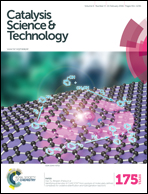Degradation and mineralization of methylene blue using a heterogeneous photo-Fenton catalyst under visible and solar light irradiation
Abstract
A SiO2-supported Fe and Ni bimetallic catalyst has been synthesized, characterized and, for the first time, tested as a heterogeneous photo-Fenton catalyst for the degradation and mineralization of methylene blue (MB) dye. The morphological, structural, and optical properties of this catalyst were analyzed using FESEM, XRD, FTIR and UV–vis spectroscopy. The photocatalytic degradation of MB has been investigated using Fe–Ni/SiO2 catalysts under visible and solar light irradiation in aqueous solutions. The effects of solution pH, H2O2 concentration, initial MB concentration, catalyst dosage and light intensity on the degradation of MB have been systematically investigated. An almost complete degradation was achieved within 60 min with a solution pH of 3.00, a H2O2 concentration of 3.0 mM L−1 and a catalyst dose of 0.85 g L−1. The degradation and total organic carbon (TOC) removal efficiencies were 99.80% and 86.19%, respectively, for sunlight. However, the values were only 99.01% and 75.71% for visible light. These results suggested that Fe–Ni/SiO2 possesses significant catalytic activity, and the solar-Fenton process is a feasible method for degrading and mineralizing the MB dye compared with artificial visible light. The catalytic action is attributed to H2O2 and the formation of hydroxyl radicals (˙OH) by Fe(III) in Fe–Ni/SiO2via the photo-Fenton reactions. Furthermore, we determined that the catalyst activity can be replicated in successive experiments without a significant decline in the Fe–Ni/SiO2 and H2O2 processing efficiency under light irradiation. Our results will be useful for future improvement of active heterogeneous photo-Fenton catalysts for developing organic dye-containing wastewater treatments.


 Please wait while we load your content...
Please wait while we load your content...